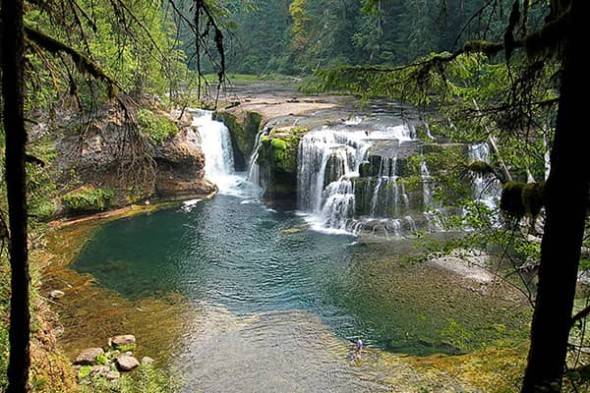Where Our Energy Comes From: Lewis River Hydropower
Posted on February 23, 2022 by Will Gehrke
Tags, Energy, General Interest

photo/image by: Flickr user pfly - flickr.com/photos/24934185@N00/235722245 CC BY-NC-ND 2.0 - creativecommons.org/licenses/by-sa/2.0/legalcode
Where does our energy come from? Here at CUB, much of our work is predicated on the belief that shedding light on this question for utility customers is good for their interests. In this blog, CUB explains the Lewis River Hydroelectric Project. Most of our readers are probably aware that a sizable portion of the power generated in the Pacific Northwest is hydroelectric. But some may be surprised to learn how much of Pacific Power’s power comes from the Lewis River in Washington.
Pacific Power’s Lewis River hydroelectric facilities are located in Southwest Washington, about forty miles northeast of Portland, Oregon. Comprised of four dams on the Lewis River, this project has an installed capacity of 550 MW. It is the largest hydroelectric facility in Pacific Power’s portfolio.
In the early 20th century, hydroelectric dams were the primary power source constructed in the Northwest. Between 1931 and 1958, Pacific Power built four dams on the Lewis River. The Lewis River starts at the Adams Glacier on Mt. Adams. It continues past the flank of Mount St. Helens on a ninety-mile flow before emptying into the Columbia River near Woodland, Washington. The drainage basin of the Lewis River is located within the Gifford Pinchot National Forest and the Mt. St. Helens National Volcanic Monument.
Despite being located in Washington state, the Lewis River project is a key source of electricity for Pacific Power’s Oregon customers. Like other hydroelectric projects, the Lewis River project is a zero carbon, local resource that draws energy from the water cycle.
The annual hydrologic cycle begins with seasonal rain and runoff from the snowpack. The runoff collects in lakes, glaciers, and streams until it reaches the Lewis River. The Lewis River project contains reservoirs that allow for the storage of water. Hydroelectric power plants with storage are unusual for a corporate-owned hydroelectric facility from the early/mid 20th century. The Lewis River dams funnel water through electric turbines to generate electricity. Hydroelectric projects with storage can adjust their output to correspond to demand and are a valuable, emissions-free way to meet the demands of electricity customers.
A major environmental concern with the Lewis River project is fish passage. The Lewis River is home to cutthroat trout and coho salmon, including both seasonally migrating and year-round populations. In addition to its critical role in the ecosystem, this fish population is important to the Cowlitz Indian Tribe and the Confederated Bands and Tribes of Yakima Nation. The Lewis River dams represent an obstacle to fish spawning in the Lewis River from the Columbia and Pacific. Pacific Power is currently constructing fish passage equipment to improve the survival rate of fish on the Lewis River while continuing to provide power from these dams.
This blog is part of an ongoing CUB Blog series exploring where our energy comes from. Visit the following links to see past installments in this series!
To keep up with CUB, like us on Facebook and follow us on Twitter!





02/23/22 | 0 Comments | Where Our Energy Comes From: Lewis River Hydropower